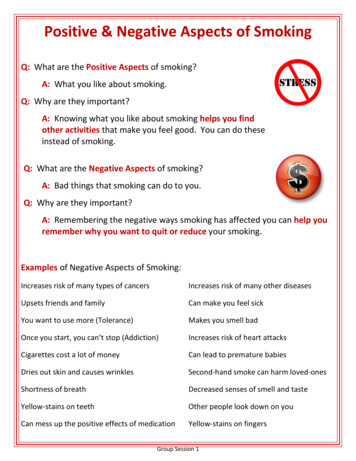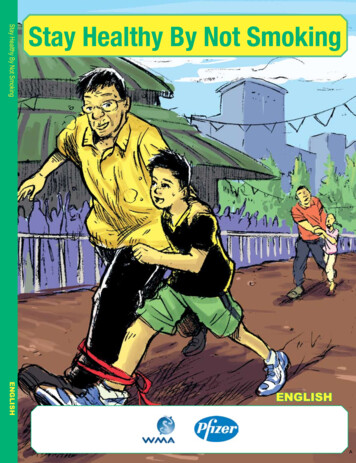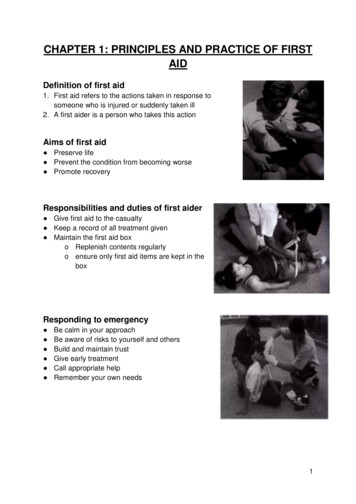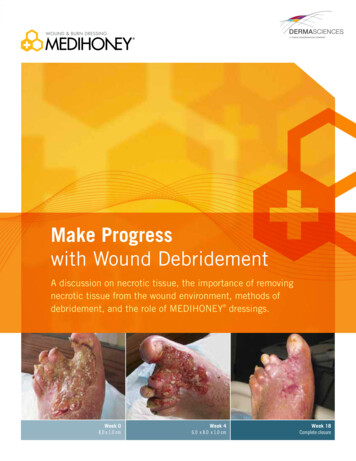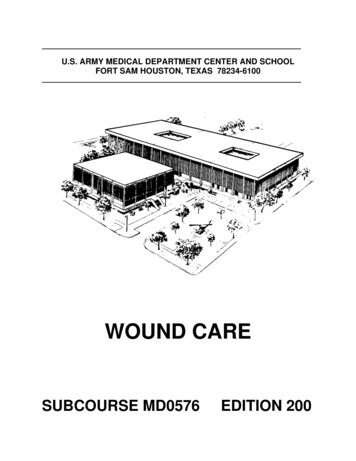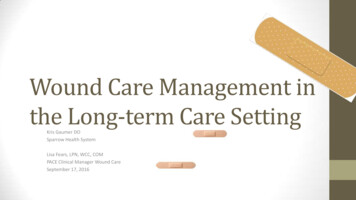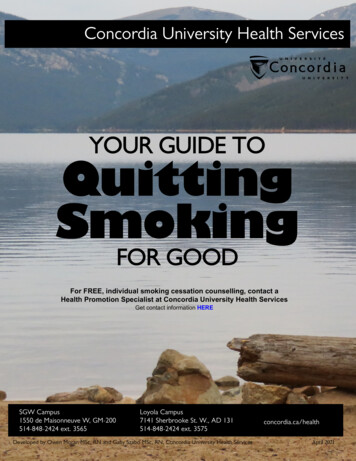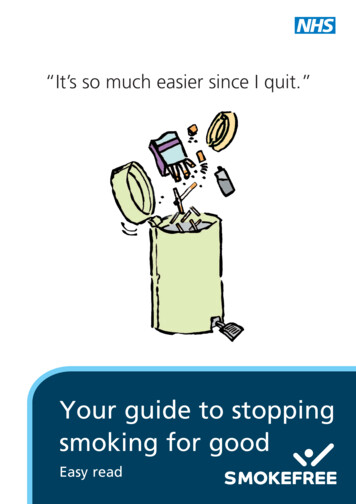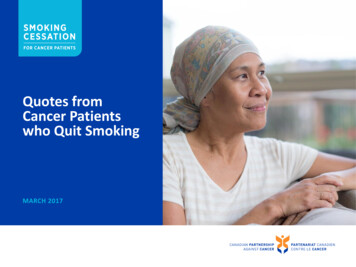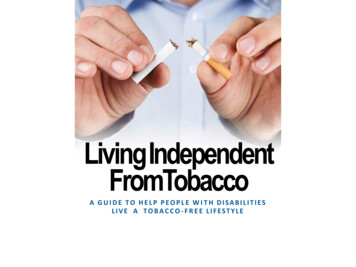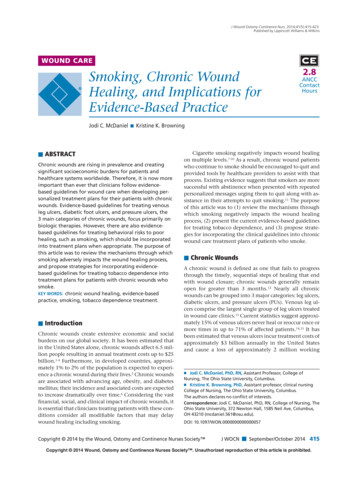
Transcription
J Wound Ostomy Continence Nurs. 2014;41(5):415-423.Published by Lippincott Williams & WilkinsWOUND CARESmoking, Chronic WoundHealing, and Implications forEvidence-Based PracticeJodi C. McDaniel Kristine K. Browning ABSTRACTChronic wounds are rising in prevalence and creatingsignificant socioeconomic burdens for patients andhealthcare systems worldwide. Therefore, it is now moreimportant than ever that clinicians follow evidencebased guidelines for wound care when developing personalized treatment plans for their patients with chronicwounds. Evidence-based guidelines for treating venousleg ulcers, diabetic foot ulcers, and pressure ulcers, the3 main categories of chronic wounds, focus primarily onbiologic therapies. However, there are also evidencebased guidelines for treating behavioral risks to poorhealing, such as smoking, which should be incorporatedinto treatment plans when appropriate. The purpose ofthis article was to review the mechanisms through whichsmoking adversely impacts the wound healing process,and propose strategies for incorporating evidencebased guidelines for treating tobacco dependence intotreatment plans for patients with chronic wounds whosmoke.KEY WORDS: chronic wound healing, evidence-basedpractice, smoking, tobacco dependence treatment. IntroductionChronic wounds create extensive economic and socialburdens on our global society. It has been estimated thatin the United States alone, chronic wounds affect 6.5 million people resulting in annual treatment costs up to 25billion.1-4 Furthermore, in developed countries, approximately 1% to 2% of the population is expected to experience a chronic wound during their lives.5 Chronic woundsare associated with advancing age, obesity, and diabetesmellitus; their incidence and associated costs are expectedto increase dramatically over time.6 Considering the vastfinancial, social, and clinical impact of chronic wounds, itis essential that clinicians treating patients with these conditions consider all modifiable factors that may delaywound healing including smoking.Cigarette smoking negatively impacts wound healingon multiple levels.7-10 As a result, chronic wound patientswho continue to smoke should be encouraged to quit andprovided tools by healthcare providers to assist with thatprocess. Existing evidence suggests that smokers are moresuccessful with abstinence when presented with repeatedpersonalized messages urging them to quit along with assistance in their attempts to quit smoking.11 The purposeof this article was to (1) review the mechanisms throughwhich smoking negatively impacts the wound healingprocess, (2) present the current evidence-based guidelinesfor treating tobacco dependence, and (3) propose strategies for incorporating the clinical guidelines into chronicwound care treatment plans of patients who smoke. Chronic WoundsA chronic wound is defined as one that fails to progressthrough the timely, sequential steps of healing that endwith wound closure; chronic wounds generally remainopen for greater than 3 months.12 Nearly all chronicwounds can be grouped into 3 major categories: leg ulcers,diabetic ulcers, and pressure ulcers (PUs). Venous leg ulcers comprise the largest single group of leg ulcers treatedin wound care clinics.13 Current statistics suggest approximately 15% of venous ulcers never heal or reoccur once ormore times in up to 71% of affected patients.14,15 It hasbeen estimated that venous ulcers incur treatment costs ofapproximately 3 billion annually in the United Statesand cause a loss of approximately 2 million working Jodi C. McDaniel, PhD, RN, Assistant Professor, College ofNursing, The Ohio State University, Columbus. Kristine K. Browning, PhD, Assistant professor, clinical nursingCollege of Nursing, The Ohio State University, Columbus.The authors declares no conflict of interests.Correspondence: Jodi C. McDaniel, PhD, RN, College of Nursing, TheOhio State University, 372 Newton Hall, 1585 Neil Ave, Columbus,OH 43210 (mcdaniel.561@osu.edu).DOI: 10.1097/WON.0000000000000057Copyright 2014 by the Wound, Ostomy and Continence Nurses Society J WOCN September/October 2014 415Copyright 2014 Wound, Ostomy and Continence Nurses Society . Unauthorized reproduction of this article is prohibited.JWOCN-D-12-00130.indd 4158/29/14 9:12 PM
416McDaniel and Browningdays.1,2,16-18 Diabetic foot ulcerations (DFUs) that fail toheal result from a combination of peripheral vascular disease and neuropathy.19 Approximately 1 in 4 individualswith diabetes mellitus will develop a foot ulcer duringtheir lifetime and 15% of DFUs will lead to amputation.20In the United States, DFUs account for 25% to 50% of thecosts related to diabetic care.21 Pressure ulcers also posesignificant problems, especially for those aged 65 years orolder who suffer from impaired mobility, inadequate nutritional intake, or a critical illness. Total annual costs related to PU care in the United States have been estimatedto be as high at 11 billion and predictions are that expenditures will continue to rise because of the growth in theaging population.22 In addition to the extensive financialcosts, PUs are associated with impaired health-relatedquality of life.22Although each of the major chronic wound types canbe characterized by unique pathobiological processes, allhave shared characteristics, including chronic inflammation, a proteolytic environment secondary to bacteria, underlying ischemia, and recurrent ischemia-reperfusioncycles.23 Cigarette smoking impairs the function of severalcell types such as neutrophils and macrophages importantto inflammatory and bactericidal activity24 and also compromises oxygen delivery to tissues. Thus, cigarette smoking has detrimental effects that compound the underlyingpathobiology of chronic wounds.10,25The harmful effects of cigarette smoking on woundhealing have been reported in multiple studies. A higherincidence of wound complications associated with smoking include prolonged wound healing times,8,9 dehiscence,26,27 tissue flap necrosis,28-30 anastomotic leakage,31decreased wound tensile strength,32 and infection.9,33,34Conversely, smoking cessation has been associated with areduction in incisional wound infections33,35 and otherwound healing complication rates.7 In fact, many surgeons are hesitant to perform certain elective or aestheticsurgeries on individuals who reject smoking cessation advice. Although few studies have evaluated the effects ofcigarette smoking specifically on chronic wound healing,the evidence of its negative impact on acute wound healing suggests that assessing for tobacco use and treatingtobacco dependence in the chronic wound populationshould be a high priority for clinicians. Smoking and Wound HealingWound healing is a complex process that can be dividedinto at least 3 continuous, but overlapping stages: an inflammatory stage, a proliferative stage leading to tissuerestoration, and tissue remodeling stage.24,36 Wound healing is regulated by a synergistic interplay among multiplecell types, cytokines, and growth factors at the wound site.Normal tissue oxygen pressures are necessary for the entire reparative process including cell migration to woundsites, bacterial defense, and collagen synthesis.37 TheJ WOCN September/October 2014healing trajectory can be interrupted at any stage by tissuehypoxia.38 Hypoxia has also been found to increase woundinfection risk in surgical patients partially due to reduction of bactericidal actions of neutrophils.39-41 Tissue hypoxia is viewed as a fundamental mechanism throughwhich cigarette smoking disrupts acute wound healing.42,43Adverse effects of smoking on tissue oxygen concentrations have been demonstrated after smoking just 1 cigarette regardless of smoking history.42,44,45 Furthermore,Jensen and colleagues42 reported that “pack-per-day”smokers experience tissue hypoxia during a significantportion of each day.It has been estimated that cigarette smoke containsmore than 4000 toxic compounds. The primary toxins associated with impaired wound healing are nicotine andthe gases carbon monoxide and hydrogen cyanide.46 Thedefinitive mechanisms through delay healing are not understood, but all have been shown to impair oxygen supply to tissues.42,47,48Perhaps the most frequently studied tobacco smokeconstituent in relation to tissue hypoxia is nicotine.Nicotine is a colorless alkaloid that is rapidly absorbedduring smoking; it is hypothesized to act as a major component of reduced blood flow owing to its vasoconstrictive actions.49 Some studies suggest that nicotine isharmful to skin and subcutaneous tissue because it stimulates the sympathetic nervous system to release catecholamines, which trigger peripheral vasoconstriction anddiminish tissue perfusion rates.50-52 Tissue perfusion ratesare also diminished by increased blood viscosity that results when catecholamines stimulate platelet aggregationvia the adenylate cyclase system. Increased blood viscosityis also thought to be a causative component of nicotineinduced tissue hypoxia.47,53 Nevertheless, evidence concerning the impact of nicotine on tissue perfusion andwound healing remains mixed. Recent studies have challenged the belief that nicotine is the major agent in tobacco smoke causing reduced blood flow, tissue hypoxia,and subsequent wound complications.25 For example,Sorensen and colleagues25 reported a temporary, marginalincrease in skin blood flow, a significant decrease in subcutaneous blood flow and no effect on the aerobic metabolism of tissue, when infusing 1.0 mg of nicotineintravenously, an amount similar to a nicotine replacement drug.25 These findings are supported by other studiesshowing that nicotine-replacement drugs had no adverseeffects on acute wound healing33,54 unless given in toxicdoses,55,56 suggesting that nicotine alone is not responsiblefor the total vasoactive effect of smoking or the association between smoking, local tissue hypoxia, and impairedwound healing.Carbon monoxide and hydrogen cyanide are also hypothesized to negatively affect wound healing. Carbonmonoxide leads to tissue hypoxia because it reduces theoxygen content of blood by binding to hemoglobin.Carbon monoxide has a 200 times greater affinity to bindCopyright 2014 Wound, Ostomy and Continence Nurses Society . Unauthorized reproduction of this article is prohibited.JWOCN-D-12-00130.indd 4168/29/14 9:12 PM
J WOCN Volume 41/Number 5hemoglobin than oxygen.46,47 As a result of a shift to theleft in the oxygen dissociation curve, oxygenated hemoglobin in the bloodstream is reduced resulting in impairedtissue profusion and cellular hypoxia.52,57 Hydrogen cyanide also affects tissue oxygenation by impeding cellularoxygen metabolism via inhibition of the enzyme systemnecessary for this metabolic process.48,58Although the exact mechanisms by which nicotine,carbon monoxide, and hydrogen cyanide lead to tissuehypoxia are not entirely understood, the negative impactof smoking on cellular function during the wound healing process has been reported by numerous studies. Forexample, cigarette smoke has been associated with a reduced proliferation of erythrocytes,47 white blood cells,47and fibroblasts.47,59,60 Diminished numbers of erythrocyteslead to inadequate oxygen availability, which results intissue hypoxia. White blood cells (macrophages) are essential for the phagocytosis of tissue debris, bacteria, andapoptotic neutrophils during the inflammatory stage ofhealing. They also generate a host of cytokines that signalsubsequent healing processes such as angiogenesis.Smoking not only reduces white blood cell migration tothe wound site, but also diminishes lymphocyte function,9,61 cytotoxicity of natural killer cells,9,61 macrophagesensing of gram-negative bacteria,62 and the bactericidalactivity of neutrophils.63 Smoking is also associated witha reduction in fibroblast proliferation during the proliferative stage of wound healing. Fibroblasts produce essential structural proteins such as collagen fibronectinthat are needed for granulation tissue formation and epithelialization.59,60,64 Collagen is the primary structural protein that affects a healing wound’s tensile strength andresearch has demonstrated that its production is diminished in smokers.65417McDaniel and BrowningConsidered collectively, these data provide compellingevidence that smoking impairs wound healing. However,most of these studies evaluated the effect of smoking onacute wound healing following surgery. Less is knownabout the influence of cigarette smoke on chronic wounds,although a relationship between smoking and an increasedlikelihood of PU formation has been observed in at least 1study of patients with spinal cord injuries.66 Figure 1 illustrates a proposed model of how smoking and the toxiccompounds contained in cigarette smoke may reduce healing in patients with chronic wound induced by venousdysfunction, prolonged exposure to pressure or shear, ordiabetes. Additional studies are needed to elucidate thespecific effects of smoking on chronic wound healing.Several clinical practice guidelines provide evidencebased practice recommendations for clinicians who treatpatients with chronic wounds.67-72 However, these guidelines do not provide specific recommendations to assistpatients in quitting smoking or techniques for tobaccodependence treatment. Creating an appendix to theguidelines containing this information would provide clinicians with the resources that are needed to help smokersquit and thus potentially improve healing outcomes forthese patients. Evidence-Based Guidelines for TreatingTobacco DependenceSmoking cessation is a dynamic process that typicallyrequires smokers to make several serious attempts beforeachieving long-term success. Many smokers express thedesire to quit smoking each year, but only one-third areactually successful.73 The US Public Health Service TreatingTobacco Use and Dependence guideline providesFIGURE 1. Detrimental effects of smoking on healing of chronic wounds. Diagram illustrating how smoking in a patient with achronic wound leads to inhalation of toxic components that have negative effects on tissue oxygenation and cellular activity inthe vascular system and microenvironment of a chronic wound.Copyright 2014 Wound, Ostomy and Continence Nurses Society . Unauthorized reproduction of this article is prohibited.JWOCN-D-12-00130.indd 4178/29/14 9:12 PM
418McDaniel and Browningevidence-based recommendations for tobacco dependence treatment.11 Several studies have examined the implementation of the US Public Health Service guideline inthe ambulatory setting and have found that approximately one-third of physician visits do not include measurement of tobacco use status73,74 despite guidelinerecommendations. When multiple clinicians (ie, physicians, nurses, pharmacists, social workers etc) advise apatient to quit smoking, it increases the patient’s motivation to quit and the number of serious attempts to quit(Table 1).11Guidelines for smoking cessation follow 5 A’s: Ask,Advise, Assess, Assist, and Arrange (Table 1).11 Patientsshould be asked about their tobacco use and it should bedocumented at every visit. Patient who smoke are advisedto quit smoking via a clear, strong personalized messagedelivered by a clinician. They should also be assessed forwillingness to quit smoking. It is critical to assess patientswho have recently quit smoking for challenges to remaining abstinent. Patients who are willing to make a quit attempt should be offered assistance with cessation withpharmacotherapy and either provided or referred to counseling or behavioral treatment. Subsequent contacts shouldbe arranged for patients to follow up on the previous “A’s”discussions. Providing routine assistance to all patientswho are interested in tobacco dependence treatment is themost important step that a clinician can provide.11 Smoking Cessation Counseling andProblem-Solving SkillsWhen counseling patients, teaching practical problemsolving skills and providing support and encouragementare important. Patients should be taught to recognize situations or smoking cues that may increase the risk of smoking or relapse such as being around other smokers, stress,or drinking alcohol. They need assistance in developingcoping skills in order to anticipate and avoid temptationand trigger situations and cope with smoking urges. Someexamples are learning distraction techniques and changing routines, assistance wtih accomplishing lifestylechanges that reduce stress and exposure to smoking cues,and learning basic information about smoking and successful quitting. Supportive counseling also may includeencouragement for quit attempts, expression of concernand willingness to help, asking about fears and ambivalence regarding quitting, and encouraging patient discussion about the quitting process.11 PharmacotherapySuccessful smoking cessation is a multicomponent strategy. Pharmacotherapy, along with behavioral counselingand problem-solving skills, offers the highest success forsmoking cessation.11,75-77 The first-line agents discussed inthis section have been found to be safe and effective forJ WOCN September/October 2014smoking cessation (Table 2). Pharmacotherapy includesnicotine replacement therapy (NRT), bupropion, andvarenicline. Bupropion was the first nonnicotine medication to show efficacy with smoking cessation and was approved for use in smoking cessation in 1997.78 The possiblemechanisms of action of bupropion include blockade ofneuronal reuptake of dopamine and norepinephrine andblockade of nicotinic acetylcholinergic receptors. It can beused in combination with nicotine replacement medications. Bupropion is contraindicated for patients with seizure disorders and anorexia nervosa or patients takingmonoamine oxidase inhibitors.Varenicline is a nonnicotine medication that has beenused for tobacco dependence treatment since 2006. It is apartial agonist of the α4β2 subtype of the nicotinic acetylcholine receptor and therefore should not be used withnicotine replacement products. Varenicline has the highest 6-month abstinence rate compared to placebo of allthe available pharmacotherapies. It is well tolerated andshould be used with a reduced dose in renal dysfunctionpatients. Patients with a history of psychiatric illnessshould be monitored closely.75Nicotine replacement agents are available in severalforms: inhalers, patches, gums, nasal sprays, and lozenges.Some are available over the counter and some by prescription only (Table 2). The goal of NRT medications is to atleast partially replace the nicotine obtained by cigarettesand to reduce the severity of nicotine withdrawal. Theform of nicotine replacement medication offered can bebased on patient preference and previous history whenattempting to quit smoking. Other factors to consider mayinclude whether the patient has dentures or skin sensitivities, in which cases the clinician may not want to recommend the gum or patch forms of NRT (Table 2).11 Smoking Cessation in PatientsWith WoundsPatients with wound healing complications typically haverecurring visits (daily, weekly, and monthly) in a woundcare clinic or home care setting. These regularly recurringvisits provide an excellent opportunity for clinicians to deliver evidence-based tobacco dependence treatment interventions to patients who continue to smoke. For woundcare patients who continue to smoke or those who are having additional difficulty with successful cessation, thefollowing 5R’s (relevance, risks, rewards, roadblocks, andrepetition) intervention may be helpful.11 The clinician canadvise a patient to quit smoking; however, it is importantto allow patients to address each topic in their own words.The clinician can fill in gaps, point out discrepancies, andhelp refine the patient’s responses. The patient must firstindicate why quitting smoking is personally relevant, beingas specific as possible. Some reasons a wound patient maycite are personal health concerns, cost, and the health effects on children or grandchildren in the home. The patientCopyright 2014 Wound, Ostomy and Continence Nurses Society . Unauthorized reproduction of this article is prohibited.JWOCN-D-12-00130.indd 4188/29/14 9:12 PM
J WOCN Volume 41/Number 5McDaniel and Browning419TABLE 1.The 5A’s Model for Treating Tobacco Use and Dependence and Suggestions for Implementing in Wound Care ClinicsThe 5A’s Model for Treating Tobacco Use and Dependencea5 A’s5A’s DefinitionsSuggestions for Implementation in a Wound Care ClinicAskSystematically, identify all tobacco users at every visit.Obtain smoking status from each patient at each visit alongwith vital signs.AdviseIn a clear, strong, personalized message, urge all tobacco usersto quit.Make connection between decreased wound healing andcontinued smoking. Use specific examples of how woundhealing is affected by smoking such as: Smoking blood flow and oxygen to wound Smoking risk of infection Smoking slows healing Smoking strength of scar tissueAssessFor current tobacco users, determine willingness to make a quitattempt.For patients willing to make a quit attempt, continue with 5A’s. For patients not ready to make a quit attempt, refer tothe 5 R’s: relevance, risk, rewards, roadblocks, andrepetition (see Strategies to promote smoking cessation inwound management patients).Assist For patients willing to make a quit attempt, help with a quit plan:䊊 Set a quit date, ideally within 2 wk䊊 Tell family, friends, and coworkers about plans to quit䊊 Anticipate challenges to the quit attempt, including nicotinewithdrawal symptoms䊊 Remove tobacco products from the environment䊊 Recommend or provide a prescription for first-linepharmacotherapy (eg, varenicline, bupropion, nicotinereplacement), See Table 2.䊊 Provide a supportive clinical environment (eg, “our clinic staffis supportive in your quit attempt).䊊 Provide supplementary materials including information on quitlines (ie, 1-800-QUIT-NOW).䊊 Strategies for after the quit date:䊏 Strive for total abstinence䊏 Identify what was helpful and not helpful during quitattempts in the past䊏 Anticipate triggers or challenges when quitting The 5 D’s areuseful when coping:䊏 DELAY: wait a few minutes; the urge to smoke will pass.䊏 DRINK: water, juice, or other soft drink (no caffeine oralcohol).䊏 DO something: take a walk, do something with yourhands, find some distraction.䊏 DEEP BREATHS: take several deep breaths (slowly in,slowly out) and the urge will pass䊏 DICUSSS: talk to someone about how you are feeling—family, friends, coworkers.䊏 Patients willing to make a quit attempt, address eachpoint listed to the left, then follow up at each visit. Patients unwilling to quit: continue to ask aboutsmoking status and advise to quit at each subsequentvisit, offering assistance if the patient shows interest. Patients who are recent quitters, congratulate on theirsuccess, and offer support and/or encouragement ateach visit.It is more difficult to quit smoking with other smokers in thehouse.For patients unwilling to quit at this time, provide interventions toincrease quit attempts in the future (see Strategies to promotesmoking cessation in wound management patients).For recent quitters, provide relapse prevention strategiesArrangeAll patients who received previous A’s should receive follow-up.Follow up with each wound patient at each visit. Serialwound care visits represent a teachable moment fortobacco dependence treatment.Adapted from the US Public Health Service Treating Tobacco Use and Dependence Clinical Practice Guideline.11aCopyright 2014 Wound, Ostomy and Continence Nurses Society . Unauthorized reproduction of this article is prohibited.JWOCN-D-12-00130.indd 4198/29/14 9:12 PM
420J WOCNMcDaniel and Browning September/October 2014TABLE 2.First-Line Pharmacotherapy (Most Effective When Used in Combination With Behavioral Warnings/Side EffectsBupropion SR (Zyban,Wellbutrin)150 mg once daily (days 1-3);150 mg twice dailyStart 1-3 wk beforequit date;duration 2-6 moPrescription only:Generic available (may becombined with nicotinereplacement therapy)Do not use with history ofseizure or eating disorders,current monoamine oxidaseinhibitor.Insomnia, dry mouthVarenicline (Chantix)0.5 mg once daily (days 1-3); 0.5mg twice daily (days 4-7); 1 mgtwice dailyStart 1 wk beforequit dateduration 3-6 moPrescription onlyUse with caution: significantrenal impairment or ondialysis, serious psychiatrichistory.Nausea, insomnia, abnormal/vivid dreamsNicotine nasal spray(Nicotrol NS)1 dose 1 squirt per nostril; 1-2doses per hour; 8-40 doses perdayduration 3-6 mo;taper at endPrescription onlyDo not use with asthma.Nasal irritationNicotine inhaler(Nicotrol inhaler)6-16 cartridges per dayInhale 80 times per cartridgeduration 6 mo;taper at endPrescription onlyLocal irritation of mouth andthroat; may improve afteruseNicotine patch(Generic, NicodermCQ, Nicotrol)One patch per day; availablestrengths: 21 mg, 14 mg, 7 mgIf 10 cigarettes per day: 21 mgIf 10 cigarettes per day: maystart with 14 mgduration 6 mo; may Over the counter;use longerGeneric availableDo not use if have severeeczema or psoriasis.Insomnia, local skin reactionNicotine Gum(Nicorette)1 piece q 1-2 hours; 6-15 piecesper day;available strengths: 2 mg, 4 mgIf 24 cigarettes: 2 mgIf 25 cigarettes: 4 mgduration 6 mo; may Over the counter;use longerGeneric availableDo not eat 15 min before orduring use.Mouth soreness, stomachacheNicotine lozenge(Commit)Weeks 1-6: 2-4 mg q 1–2 hWeeks 7-9: 2-4 mg q 2-4 hWeeks 10-12: 1-2 mg q 4-8 havailable strengths: 2 mg, 4 mgduration 3-6 moDo not eat 15 min before orduring use.Hiccups, cough, heartburnOver the counter;Generic availableAdapted from the US Public Health Service Treating Tobacco Use and Dependence Clinical Practice Guideline.11ashould next identify potential risks associated with continuing to smoke such as decreased blood flow and oxygento wound, increased risk of infection, slower healing, anddecreased strength of scar tissue. It is important for the patient to identify potential rewards of smoking cessationsuch as faster healing of wound, increased mobility or activity following wound healing, alleviation of comorbidhealth conditions such as coronary heart disease and peripheral vascular disease, improved pulmonary symptoms,cough and dyspnea, and improved smell and taste thatmay lead to improved nutritional intake and thus fasterwound healing.Finally, the patient should identify barriers or roadblocks to quitting and the clinician should provide counseling or interventions that address these barriers such asproblem-solving counseling, or medications discussed inthe general recommendations section. Typical roadblocksto successfully quitting smoking may include withdrawalsymptoms, fear of failure, weight gain, lack of support,depression, fear of losing the enjoyment of tobacco, beingaround other tobacco users, and limited knowledge of effective tobacco dependence treatment. Roadblocks specific to patients with chronic wounds frequently includeimmobility that prohibits working or regular daily activities. Lack of daily activities due to immobility may lead toboredom or anxiety, which may decrease the likelihood ofsuccess in quitting. We recommend repeating the 5 R’severy time the patient sees the clinician. ConclusionChronic wounds are a significant health problem. Woundhealing may be impaired by multiple factors, includingsmoking. Because cigarette smoking is a modifiable factor,WOC nurses and other wound care clinicians should incorporate personalized, evidence-based smoking cessationstrategies in their care plans in order to improve healingoutcomes in this population.Copyright 2014 Wound, Ostomy and Continence Nurses Society . Unauthorized reproduction of this article is prohibited.JWOCN-D-12-00130.indd 4208/29/14 9:12 PM
J WOCN Volume 41/Number 5KEY POINTS Although the exact mechanisms by which smokingcompromises wound healing are not entirely understood, thenegative impact of smoking has been reported by numerousstudies. Wound care guidelines could be expanded to include thetreatment of behavioral risks to poor healing, such as smoking. WOC nurses and other wound care clinicians should providethe resources to aid patients with chronic wounds to quitsmoking. ACKNOWLEDGMENTSThe authors are supported in part by funding from thefollowing sources: National Institutes of Health Clinicaland Translational Science Award to The Ohio StateUniversity UL1RR025755, NIH/NINR 1R21NR01280301A1 (J.M.). References1. Abbade LP, Lastoria S. Venous ulcer: epidemiology, physiopathology, diagnosis and treatment. Int J Dermatol. 2005;44(6):449456. doi:10.1111/j.1365-4632.2004.02456.x.2. Valencia IC, Falabella A, Kirsner RS, Eaglstein WH. Chronic venous insufficiency and venous leg ulceration. J Am AcadDermatol. 2001;44(3):401-421; quiz 422-424. doi:10.1067/mjd.2001.111633.3. Gordon MD, Gottschlich MM, Helvig EI, Marvin JA, RichardRL. Review of evidenced-based practice for the prevention ofpressure sores in burn patients. J Burn Care Rehabil.2004;25(5):388-410.4. Driver VR, Fabbi M, Lavery LA, Gibbons G. The costs of diabetic foot: the economic case for the limb salvage team. J AmPodiatr Med Assoc. 2010;100(5):335-341.5. Gottrup F. A specialized wound-healing center concept: importance of a multidisciplinary department structure and surgicaltreatment facilities in the treatment of chronic wounds. Am JSurg. 2004;187(5A):38S-43S. doi:10.1016/S0002-9610(03)00303-9.6. Sen CK, Gordillo GM, Roy S, et al. Human skin wounds: amajor and snowballing threat to public health and the economy. Wound Repair Regen. 2009;17(6):763-771. doi:10.1111/j.1524-475X.2009.00543.x.7. Chan LK, Withey S, Butler PE. Smoking and wound healingproblems in reduction mammaplasty: Is the introduction ofurine nicotine testing justified? Ann Plast Surg. 2006;56(2):111115. doi
Smoking and Wound Healing Wound healing is a complex process that can be divided into at least 3 continuous, but overlapping stages: an in-fl ammatory stage, a proliferative stage leading to tissue restoration, and tissue remodeling stage. 24, 36 Wound heal-ing is regulated by a synergistic interplay among multiple
